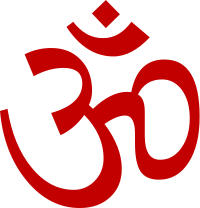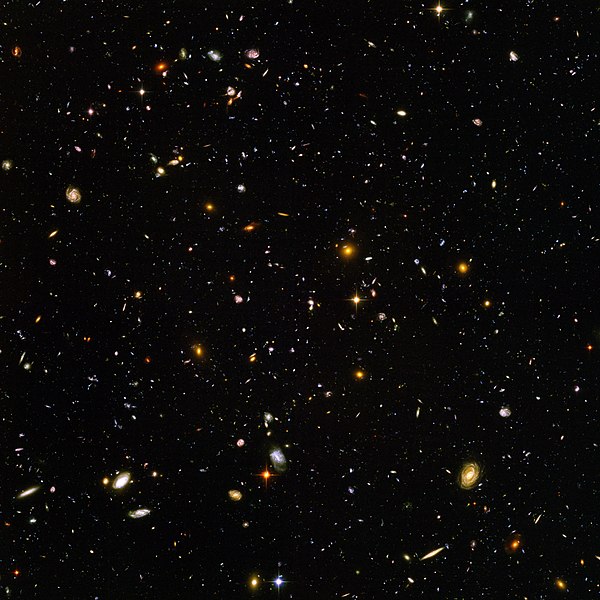Dharma 101 at the United Church of Christ

I gave an overview of Sanatana Dharma at the United Church of Christ a few nights ago. Around 50 people attended, and some stayed around for more discussion. The speaking engagement was part of an outreach effort by UCC for inter-faith dialog, and my participation came about through a fortuitous chain of acquaintances.
I am writing down (in slightly modified and readable form) some of the salient points that I covered.
I am a Hindu If You Preach Palestinism


First off, I don’t call myself a Hindu, just as you don’t practice Palestinism.
When the Arabs and Persians encountered the civilization near the river Sindhu, they called the inhabitants Hindu, and the land around and beyond as Hindustan. In the intervening centuries, the label “Hindu” distinguished the population from the invaders, was rarely contested, and then appropriated culturally and socially. But in our discussion, it is better to use the word Dharma, and specifically Sanatana Dharma.
Dharma Eternal
Sanatana means Eternal, without beginning and without end. Dharma is best left untranslated. Dharma derives from roots meaning “Sustained, Firm” and is the Power or Law behind “Rta”, the correct way, the right order, natural justice, harmony and righteousness.
Dharma is therefore Universal, and applies to all beings, times and places. Dharma exists, acts and informs our reality, whether we as beings understand it or not. But those of higher awareness consciously choose to seek, follow and uphold Dharma. Thus, even gods must act based on Dharma.
Dharma can be sought and practiced by anyone, anywhere in any time or age. However, since time immemorial, and throughout the ages, devas and humans have, out of compassion and a sense of duty, left markers and guides for our understanding. These comprise of the shruti (that which is heard), smriti (that which is remembered), puranas (of ancient times), itihasa (history - thus, it was) and numerous sutras (compendia) and bhashyas (commentaries). Shruti is the cosmic sound of truth, heard and transcribed by rishis into a language and structure that can be understood by humans. This knowledge or wisdom is the Vedas which are “apaurusheya”, unauthored and divinely inspired.
Creation

Cycles of creation and dissolution are accepted to be vast, and work at many levels with different time spans. The Puranas provide detailed lists of the different Manus (progenitor of humans), and the salient kings and rishis of the this and previous ages.
To illustrate, we are now in the SvetaVaraha Kalpa which is this Day of Brahma lasting 4.32 billion human years. We are about half-way through this Day, being in the 4th and final Yuga of the 28th MahaYuga (out of 71) of the 7th out of 14 Manvantara of this Kalpa. This KaliYuga began in 3102 BCE with the Mahabharata war.
You may choose to focus on Creation, however Dharma transcends Creation. Let’s hold that thought for a minute, while we think of a Creator.
Normally, at this point, I take a deep breath and brace myself for Anti-Theistic arguments, but here, I don’t need to.
Now there have been materialistic schools of thought, such as Charvaka, who argued that what we perceive with our senses is all that there is, and when the senses shut off, upon death, there is nothing left, and therefore nothing more. But it has no contradiction with Dharma, because if you accept certain ethics, whether for ensuring more pleasure, or encountering less pain, then you have accepted the notion of underlying Dharma, even if you do not attempt to understand it, but practice it merely out of personal desires.
Neti Neti

The Blind Men and the Elephant is a great poem based on the fable from India, where six blind men argue about the nature of the elephant. Its a good thing to remember, as we apply our limited senses to conceptualize the Creation and Origins while being part of the Creation.
A natural question with positing a Creator, is who created the Creator? And then who created that creator of the creator? And so on, obviously, with no end. Most people when faced with this logical infinity decide that the problem is best left to the immediate Creator, or that it is useless to think of a Creator, or they reject such notions or ignore the issue entirely, or declare that it is not important.
The Vedas and the Upanishads on the other hand, deem it central to the human condition and provide us with several ways to contemplate Its Nature and arrive at an understanding.
First, is an approach, called Neti Neti, which means “Neither This, Nor That”. It helps us avoid using or applying inadequate words and insufficient perceptions.
Second is illustrative analogies.
For example, in the Chandogya Upanishad, Svetaketu is asked by his father to do simple tasks such as cutting a fig into smaller and smaller pieces, or mixing salt in water. Svetaketu reasons that while the salt has disappeared, for all practical purposes, it has imparted its qualities to the water. When asked to cut the seed of the fig, Svetaketu, with great effort does so, and realizes that there is still something beyond the seed, which brings forth the fig tree, and is the essence of the fig.



Similarly, there is an all-pervading and transcendent essence which is the basis for all matter, energy, time, space and beings and is called Brahman.
Nirguna Brahman is the Formless, Immanent Reality. It is pervasive, and is within you, me, our self. It is the Universal Consciousness. It is the sub-quantum force, the Nothingness below the quantum level which still gives atoms and materials their properties. It is the directive force that ensures that while a typical protein molecule can fold itself in 10^143 ways, in practice it does so in only a few dozen stable and useful ways.
Third, and most importantly, is a way for us to relate to this impersonal vastness and cosmic infinity in terms of our individual capabilities.
Sat-Chit-Ananda
Most people when they watch TV don’t think about the physics of cathode ray tubes or liquid crystal displays, or the electromagnetic properties of light that allow them to remotely change the channel. Even the physicist comes home and gets engaged in the human drama and emotions that are being played out on the screen.Similarly, most devotees when worshipping need more than the abstractions that we discussed. We all need tangible things we can relate to.
Saguna Brahman is Brahman with attributes and forms that we can relate to. These attributes help us visualize the Power and Glory and help us in leading the life of Dharma. For their devotees,Vishnu, Shiva and Shakti are the main manifestations of Brahman and worship through them leads to Truth, Awareness and Bliss. That is Sat-Chit-Ananda.
For you, the Ishta-Devata, or the Cherished Divine takes the form of Christ, and through Jesus you can relate to those attributes such as mercy, compassion, patience and suffering, and it informs your practices and conduct.
As Krishna explains in the Bhagavad Gita: “To protect the pious and destroy the evil-doers, And reestablish Dharma, I appear from Yuga to Yuga” and “Those devotees who worship any deity with faith, actually worship only Me, even if imperfectly.”
Atman, Brahman, Moksha and Karma
As Svetaketu’s father tells him, Tat Tvam Asi (You Are That), or Brahman is within us, and We are Within Brahman. It is easy for me to repeat this, and understand it intellectually. It is the Understanding, the “just knowing” part which is hard.
I think we all watched the Winter Olympics last month. It is easy to critique the skiers on their performance. It is a bit more work to put on the skis and listen to an expert skier tell us what to do and explain the techniques. It is harder to apply those techniques. And it is only after doing all those practices, where you stop thinking of the technique, and just know, that you are doing great. The feeling of flow where you are doing something naturally. Similarly, a state of “just knowing” about your true Self, Atman and the nature of Brahman, is called Moksha, and is considered the highest aim that humans should strive for.
But, perhaps you need more time to reach this Understanding. Or you may not be inclined towards achieving that. Or you may be distracted right now with other things. That is the nature of this world, the Samsara, and most people are born, live and die without realizing that insight, without achieving Moksha.
How is it that babies have personalities and inclinations? Why are some people more intense in certain endeavors than others? In the Bhagavad Gita, Krishna describes to Arjuna the nature of Atman as indestructible, retaining its essence and yet growing with its experiences. As a person changes clothes, so does Atman change bodies, being reborn again and again, until it achieves Moksha and unites with Brahman.
Why are some people born with more and some with less?You are free to choose your course of action (Karma), but the consequences of those actions (Karma) are yours as well.
Thus, Dharma is maintained through Karma and Karma leads to Dharma.
Practice
Dharma is experiential, and so there is great emphasis on practice. It is a process, a journey of discovery, even as you remain engaged in this world, whether in achieving worldly goals or by renouncing them in favor of knowledge and service to others.
A great amount of Dharma-Shastras (or Scientific Guide for Dharma) have been written to prescribe daily rituals and practices for Dharma at an individual as well as societal level. They cover topics ranging from hygiene to health, from how to worship to how to gather wealth, and for mindfulness through meditation. The Bhagavad Gita is the quintessential modern manual for practice, with detailed explanations and reasonings behind the different paths, namely: Devotion, Action, Knowledge, Meditation, Renunciation and so on.
Yoga is the term used in Bhagavad Gita for these paths, and Yoga is the same as “yoke” to join. In the physical Yoga, we join mind and body to be aware, and calm the oscillations of the mind, which in turn helps us in our pursuit of Dharma.
Other aspects of practice, which might sound familiar to you all, include:
- japa - the chanting of mantras
- pooja - the ritual worship through iconic forms
- satsang - congregations for devotion and worship
- bhajan - devotional singing
- darshan - visits to temples for viewing and focusing on the divine
- vrata - taking and carrying out vows
- yatra - pilgrimage
- yadna - sacrificial ceremonies
Shanti Mantra
The Shanti Mantra is a great non-denominational way to open and close discourses. I think it is a quintessential aspect of our gathering here today. Its easy enough for you to read and recite with me.
Om saha nAvavatu (May we be protected together) saha nau bhunaktu (May we be nourished together) saha viryam karavAvahai (May we achieveand work together) tejasvinAvadhitamastu (May we shine forth together) ma vidvishawahai (Let no hate come between us) Om Shanti Shanti Shanti